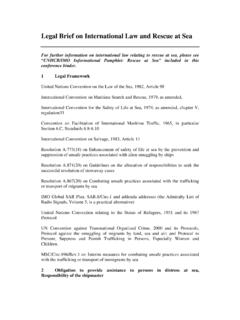Transcription of Your guide to a successful ERP journey - Deloitte
1 Your guide to a successful ERP journeyTop 10 change management challenges for Enterprise Resource Planning implementationsContentsPlan the trip ..21 Get everyone on board ..32 Make sure someone s removing roadblocks ..43 Check the rear-view mirror ..5 Hit the road ..64 Put the horse before the cart ..75 Prepare for detours ..86 Ask for directions along the way ..97 Teach them to drive the new standard ..11It s a journey , not a destination ..128 Stay on the right side of the tracks ..139 Use the GPS system get participation swiftly ..1410 Missing a turn doesn t mean the end of the road ..15 With the price of gas these The single biggest failure point for ERP implementations is the need for change management. Neville Turbet, Project Perfect1 Your guide to a successful ERP journeyMajor project failure is an unfortunate fact for many organizations, and Enterprise Resource Planning (ERP) projects are no exception.
2 Analyst firm Gartner estimates that 55% to 75% of all ERP projects fail to meet their objectives. Whether your project is a few months or a few years long, whether it s an upgrade or a new implementation , the financial and cultural well-being of the entire organization is at stake, and the associated costs of failure range from disruptive to catastrophic. You must do everything possible to ensure success. Fortunately, while failure is common, it is not unavoidable. Deloitte has identified the critical people-related challenges organizations typically face at each phase of an ERP implementation , as well as specific steps you can take to mitigate them. With so much on the line, consider what your organization can do to minimize risk and make your ERP project implementation journey as smooth as possible.
3 2 Your guide to a successful ERP journeyProject preparation is a make-or-break imperative Plan the trip3 Your guide to a successful ERP journeyGet everyone on board Understand and articulate the need for changeTo address these challenges Define the need for change by developing a clear picture of how the organization will benefit from this initiative. This can go a long way to gaining buy-in and generating enthusiasm for the implementation . Articulate and endorse the vision. Spend time upfront communicating why this change is necessary and what will happen if you don t change. Leaders, particularly in areas likely to be affected, need to cascade this message down to staff. Be clear on the budget and resources required to support the project, and determine the resource ramp-up plan so the project doesn t stall at the start.
4 Also, make sure everyone involved understands the commitment required from all parties. This will help avoid confusion when competing initiatives inevitably beginning any ERP project, it s critical to ensure that the entire organization understands the reasons and strategy behind the move. If decision makers do not clearly support the need for change, your budget and resource planning may be negatively affected. If project members and end users don t understand the objectives, confusion can prevail over purpose and commitment, increasing resistance to change and reducing the chance of success. 14 Your guide to a successful ERP journey Determine and clearly communicate who the project sponsor is at the start. This is where the buck stops and the sponsor must have the authority to remove roadblocks.
5 Identify other organizational leaders who need to support and understand the change. These leaders will be very helpful in removing barriers to success. Understanding the political climate allows the implementation team to determine the best way to position the project with various leaders. A guiding coalition that is in agreement is critical for success. Put on a roadshow presentation for leaders to ensure they are aware and fully understand the purpose and expected benefits of the project. They will be important allies on the road ahead equip them well. Create leadership alignment plans for identified leaders, with key actions they can undertake to visibly support the project. Include incentives as an integral part of the sponsor s and leaders performance plans, based on their achievement of objectives related to the project.
6 Proactively facilitate cross-functional sessions with leaders early on to gain a shared understanding of the project, its objectives and potential barriers, as well as the important role leaders will play sure someone s removing roadblocksAdequate sponsorship and leadership are critical to successMany issues raise stumbling blocks over the course of an ERP initiative, so be sure you begin on solid footing. To garner the necessary support, and motivate project members and end users, the implementation must be viewed as a high priority. Appropriate, authoritative sponsorship must visibly drive the project from the outset. Without day-one endorsement and guidance from all levels of leadership, your project can be over before it begins. A lack of clear sponsorship or leadership can also negatively affect the decision-making process and impede progress.
7 The most important role the sponsor and other leaders play in an ERP implementation is helping to remove barriers to success for the ensure adequate sponsorship and leadership25 Your guide to a successful ERP journeyOften times, an understanding of history facilitates future success. For ERP implementations, organizations should consider how resulting changes fit in with or can be adapted to the prevailing business culture, as well as what success the organization has had with past change-based projects. Understanding cultural alignment and change history, as well as the status of current competing initiatives, can help appropriately prioritize the project and strategically design it to succeed. If an organization that has not handled change well in the past is subjected to substantial further change, it may result in organization change fatigue, which can lead to a lack of engagement and project commitment.
8 Also, if the change is not communicated in a way that highlights its alignment with the organization s culture, there will likely be resistance from the the rear-view mirrorUnderstand established business culture and historical response to change To alleviate these risks Determine the priority of initiatives currently under way or planned for the near term. Knowing where the ERP implementation fits into the organization s priorities is key to getting the resources and commitment required to stay on time and on budget. Create a dashboard that highlights the resources, budget and timeline for each project to avoid potential conflicts. Include a detailed change management and communication plan to support each phase of the ERP implementation . Change management activities such as change readiness assessments, which provide insight into past history with change and how ready and willing the organization is to adopt the changes, can help position the implementation appropriately with end users.
9 They can also identify mitigation tactics to avoid change guide to a successful ERP journeyDesign, build and implement effective solutionsHitthe road7 Your guide to a successful ERP journeyLack of clarity around structure, activities, roles and responsibilities can result in confusion and resistance, making project execution extremely difficult. Without a clearly developed and articulated project structure, the project team may duplicate efforts or leave key tasks unaddressed as they try to figure out where they should be and what they are specifically responsible for. Inevitably, this causes delays and redundancies before the project gets in gear, raising costs and jeopardizing budgets and help your project move forward with organization-wide clarity and understandingPut the horse before the cartAppropriately structure the project and clearly establish roles Hold a project kick-off session to set and align expectations, clarify roles and responsibilities and allow team members to bond and have their questions answered.
10 Include the project sponsor to ensure visibility and involvement from the outset. Understand and leverage existing internal structures such as communication vehicles and decision-making bodies that can assist throughout the implementation . These structures create a sense of familiarity and reduce barriers to engagement. Develop and enforce a clear issue and risk escalation process to capture, and expeditiously deal with, all issues and risks throughout the project. Highlight integration points between project streams to generate discussion early on. Initial all-staff meetings should include presentations from each stream on what they understand their project role to be, and what they see as key integration points with other streams. Revisit and reinforce roles and responsibilities regularly throughout the project life cycle as they may shift or evolve over time.












